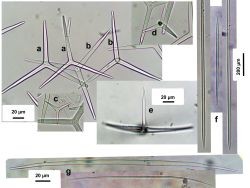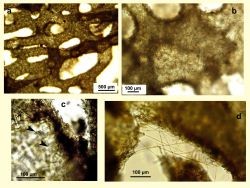yellow
encrusting
massive
soft
Bahamas
United States
Clathrina sp.1-“yellow with tri- and tetractines"
Description: Encrusting to globular masses up to 2-3 cm in size, spreading laterally in an irregular fashion. Color bright lemon yellow. Consistency is soft. Masses are made of a network of loosely intermingled and anastomosed thin tubes (125-500 µm in diameter), forming meshes of up to 2-3 mm, which here and there become confluent to form raised, paper thin oscules; there is not an outer membrane covering the mass. Tubes are lined tangentially by a skeletal 20-40 µm layer of 2-4 superimposed spicules. Spicules are calcareous, mainly triactine and tetractines of similar size, equiradiate and equiangular, 70-110 µm long by 8.5-10 µm thick (at the base); actines have slightly sinuous edges and end in somewhat blunt tips. Apical actines of tetractines are thinner and sharp or blunt, straight to curved, 70-110 µm long and 6-9 µm thick at the base. This apical actine can be seen projected perpendicularly into the lumen of the tubes, while the other three rays form the tangential skeleton. There are smaller tri- and tetractines of equal shape to the larger, 32-60 µm long by up to 7.5 µm wide; it was not established if they conform a separate size category. In some places of the specimens analyzed there were thin (up to 2.5 µm), very long trichoxeas with short and pointed ends, arranged apparently tangential in the tube skeleton; in spicule preparations these appeared broken; the only complete spicule found measured 33 µm. A few diactines were seen in spicule preparations but not in tissue sections, smooth and with both ends slightly curved in the same or in opposite directions, 185-320 µm long by up to 7.5 µm thick.
Notes: This species lives in mangroves, dock pilings and undersides of caves and corals in shallow water. Except for the presence of diactines and trichoxea, this species seems to conforms to what de Laubenfels (1936: 201, Pl. 22, fig. 4) described from Dry Tortugas, Florida, as Clathrina canariensis, having many large (75 by 6 µm) and a few smaller (25 by 4 µm) tri- and tetractine spicules. The original Clathrina canariensis (Micklucho-Maclay, 1868) from the Canary Islands is white in color. Our material did not conform to any of the tropical and subtropical Western Atlantic species described in the worldwide revision of the genus Clathrina carried out by Klautau & Valentine (2003). The only other Clathrina from the Caribbean having both tri- and tetractines is Clathrina panis (Haeckel, 1872), from Florida; its live color is not known, but it possesses a large atrium, lacking in our material, and it has much larger spicules (135-180 x 15-16 µm vs. 70-92 x 8.5-10 µm here; diactines 286-1122 x 30 µm vs. 200-320 x up to 7.5 µm here, if propper). In a molecular phylogeny analysis, Klautau et al. (2013) changed the definition of the genus Clathrina to strictly include those species having exclusively triactines, allocating the rest among genera Ascandra, Borojevia, Brattegardia or Ernstia. As we were not able to ascribe our material to any of these proposed genera, we kept to Clathrina as a working name for the time being. Care should be taken when identifying this species, as one of the analyzed specimens had another thin tubular calcareous sponge intermingled among its tubes, making identification of proper spicule types difficult, although these could be discriminated by their slightly different hue under the light microscope in Permount preparations. This species could be confused in the field with Clathrina sp.2-"yellow with only triactines", also pictured in this guide, which is a yellow cryptic species, but differs in having a much tighter arrangement of tubes and exclusively triactines.


